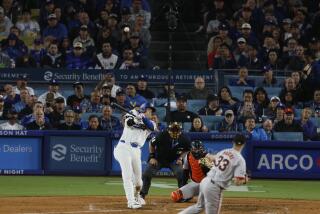Diamonds Aren’t Baseball Player’s Best Friend
- Share via
Talk about a baseball diamond.
Actually, two of them, one on each lobe of Seattle Mariner relief pitcher Arthur Rhodes, who was ordered to remove his diamond earrings twice--the first time Saturday because the right dazzler was a distraction to Cleveland Indian batter Omar Vizquel, the next on Sunday in order to avoid a similar situation.
Talk about style getting thrown a curveball. Hey, batter, batter.
Major league umpire crew chief Tim McClelland, who ejected the earrings--and then Rhodes--in the first game, will tell you that you gotta be a good sport when it comes to fashion on the field.
“It’s been a very strange last few days,” McClelland says about all the attention to the earring incident at Safeco Field that was captured on national television.
Who knew that earrings would get such a high-profile--dare we say it--pitch?
Coincidentally, on Monday, Barry Bonds, the San Francisco Giants’ earring-wearing home run slugger, revealed he had recently removed the diamond stud he wears in his left ear because of an infection--not because of the flap involving Rhodes. Bonds told the Associated Press that his ear was bleeding so he removed the earring.
“For sure, more guys are wearing earrings--fielders and hitters are wearing them, more pitchers are wearing them,” says McClelland, who was in L.A. on Wednesday and Thursday to work the Dodgers-versus-the Colorado Rockies games. “I first started noticing that five or six years ago with a guy wearing an earring.”
But this was the first time in his 19-year career that he had to ask a player to remove jewelry. “Guys in the real world are wearing them, so it was just a matter of time until baseball players would be wearing them, too,” he adds, admitting he’s “too old-fashioned” to don diamonds on his ears.
For the record, Major League Baseball spokesman Richard Levin says from his New York office that baseball clubs were reminded earlier this year about a rule regarding jewelry on the diamond that reads, “No field personnel may wear distracting jewelry of any kind.”
Furthermore, an umpire may ask a player to remove the jewelry if it is disruptive, according to the Cocoa, Fla.-based World Umpire’s Assn. Which McClelland, a union member, did after Vizquel complained that the bright Seattle sunlight was reflecting off Rhodes’ right earring and “blinding” the batter during the Saturday game.
“Rhodes took the earrings off begrudgingly” but was also ejected from the game because he “made comments that could have instigated further problems,” McClelland says. Rhodes was unavailable for comment; the team was on the road.
McClelland says had the game started an hour earlier or later, “the sun would have been at a different angle and not reflected off the earring.”
As for the size of the rocks, the ump says, “They were nice, big, beautiful, bright diamonds. I have to give him credit for that.”
Jacob Arabo, known as New York’s Jacob the Jeweler, has sold many an earring and pairs of them to baseballers, boxers and rock stars such as Fred Durst of Limp Bizkit and rappers Jay-Z, P. Diddy and LL Cool J.
“Diamonds can cause a glare and hurt someone else’s eyes if the light hits it just right. This guy must have had some nice diamonds on,” Arabo says, adding that the biggest diamond studs he has ever sold were to a rapper named Baby who plunked down $350,000 for a pair of earrings, each 15 carats and requiring double clasps for two holes in each ear. “They were each the size of an eyeball,” he says.
Bruce Arnold, a third-generation jeweler who operates Arnold’s Fine Jewelry in Pasadena, says if a diamond is properly cut “it is within the realm of possibility that a flash of light might be able to reach a batter--what, some 90 feet away.” However, he thinks the answers might have more to do with the tensions of a game that is tied in the ninth inning “than in the optical properties that a diamond might have.”
More to Read
Go beyond the scoreboard
Get the latest on L.A.'s teams in the daily Sports Report newsletter.
You may occasionally receive promotional content from the Los Angeles Times.









